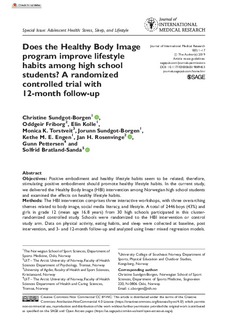| dc.contributor.author | Borgen, Christine Sundgot | |
| dc.contributor.author | Friborg, Oddgeir | |
| dc.contributor.author | Kolle, Elin | |
| dc.contributor.author | Torstveit, Monica Klungland | |
| dc.contributor.author | Sundgot-Borgen, Jorunn | |
| dc.contributor.author | Engen, Kethe Marie Elgesem | |
| dc.contributor.author | Rosenvinge, Jan H | |
| dc.contributor.author | Pettersen, Gunn | |
| dc.contributor.author | Bratland-Sanda, Solfrid | |
| dc.date.accessioned | 2019-12-11T12:42:06Z | |
| dc.date.available | 2019-12-11T12:42:06Z | |
| dc.date.created | 2019-12-05T17:57:04Z | |
| dc.date.issued | 2019 | |
| dc.identifier.citation | Journal of international medical research. 2019, 1-17. | nb_NO |
| dc.identifier.issn | 0300-0605 | |
| dc.identifier.uri | http://hdl.handle.net/11250/2632745 | |
| dc.description | Creative Commons Non Commercial CC BY-NC: This article is distributed under the terms of the Creative Commons Attribution-NonCommercial 4.0 License which permits non-commercial use, reproduction and distribution of the work without further permission provided the original work is attributed as specified on the SAGE and Open Access pages | nb_NO |
| dc.description.abstract | Objectives
Positive embodiment and healthy lifestyle habits seem to be related; therefore, stimulating positive embodiment should promote healthy lifestyle habits. In the current study, we delivered the Healthy Body Image (HBI) intervention among Norwegian high school students and examined the effects on healthy lifestyle habits.
Methods
The HBI intervention comprises three interactive workshops, with three overarching themes related to body image, social media literacy, and lifestyle. A total of 2446 boys (43%) and girls in grade 12 (mean age 16.8 years) from 30 high schools participated in this cluster-randomized controlled study. Schools were randomized to the HBI intervention or control study arm. Data on physical activity, eating habits, and sleep were collected at baseline, post intervention, and 3- and 12-month follow-up and analyzed using linear mixed regression models.
Results
The intervention had a minor negative effect on physical activity levels in boys at 12-month follow-up and short-term small-to-moderate positive effects on consumption of breakfast and fruit and vegetables, and sleep duration on school days.
Conclusions
In future, the lack of satisfactorily long-term effects might be better addressed using a combination of cognitive and behavioral approaches to more optimally integrate positive embodiment and lifestyle changes in the daily life of adolescents. | nb_NO |
| dc.language.iso | eng | nb_NO |
| dc.rights | Navngivelse-Ikkekommersiell 4.0 Internasjonal | * |
| dc.rights.uri | http://creativecommons.org/licenses/by-nc/4.0/deed.no | * |
| dc.title | Does the Healthy Body Image program improve lifestyle habits among high-schoolstudents? A radndomised controlled trial With 12-month follow-up. | nb_NO |
| dc.type | Journal article | nb_NO |
| dc.type | Peer reviewed | nb_NO |
| dc.description.version | publishedVersion | nb_NO |
| dc.rights.holder | (c) The Author(s) 2019 | nb_NO |
| dc.source.pagenumber | 1-17 | nb_NO |
| dc.source.journal | Journal of international medical research | nb_NO |
| dc.identifier.doi | https://doi.org/10.1177%2F0300060519889453 | |
| dc.identifier.cristin | 1757345 | |
| cristin.unitcode | 222,59,4,0 | |
| cristin.unitname | Institutt for friluftsliv, idrett og kroppsøving | |
| cristin.ispublished | true | |
| cristin.fulltext | original | |
| cristin.qualitycode | 1 | |

